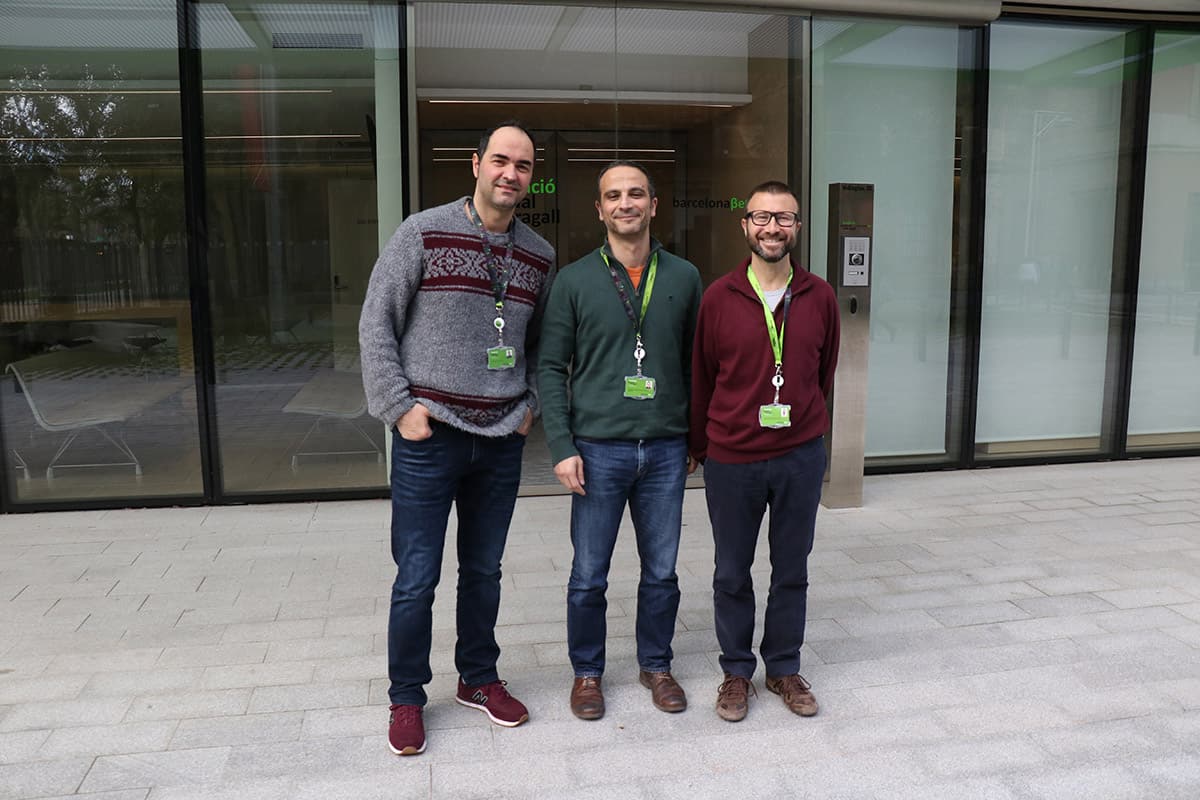
The research center of the Pasqual Maragall Foundation, with the support of the Fundación Bancaria “la Caixa”, publishes the largest neuroimaging study conducted in healthy individuals who carry the APOE-Ɛ4 gene variant, which confers risk for developing Alzheimer’s disease.
Pioneering study detects alterations in brain structure in healthy individuals at risk of Alzheimer’s
The research center of the Pasqual Maragall Foundation, with the support of the Fundación Bancaria “la Caixa”, publishes the largest neuroimaging study conducted in healthy individuals who carry the APOE-Ɛ4 gene variant, which confers risk for developing Alzheimer’s disease.
Àngel Font, Corporate Director of Research and Strategy of the Fundación Bancaria “la Caixa”, and doctors José Luis Molinuevo and Juan Domingo Gispert from the Barcelonaβeta Brain Research Center (BBRC) of the Pasqual Maragall Foundation, have presented in the Palau Macaya a pioneering international study published online in the prestigious scientific journal Alzheimer’s & Dementia: The Journal of the Alzheimer’s Association.
The study detected morphological brain alterations in healthy individuals who are carriers of the APOE-Ɛ4, which is the gene that confers the highest risk to develop Alzheimer’s disease. The research has been possible thanks to the magnetic resonance imaging tests carried out within the Alfa Study and represents the largest neuroimaging study in healthy carriers of the APOE-Ɛ4.
“The morphological differences that we found are associated with Alzheimer’s disease because they appear in brain areas such as the hippocampus, which is among the first brain region suffering the neurodegeneration process of the disease”, reports the first author of the study, Raffaele Cacciaglia.
On the other hand, Àngel Font, highlights that “research is the only way to advance towards the early detection and the prevention of this disease that could be the upcoming pandemic of the 21st century. We have always been aware of the importance of reducing the occurrence of new cases, and this is why we have been supporting the Pasqual Maragall Foundation since its establishment, in 2008”.
The study was led by the team of José Luis Molinuevo and Juan Domingo Gispert at the BBRC, with the collaboration of the head of the Cancer Epigenetics and Biology Program of the IDIBELL, Manel Esteller, who carried out the genetic determinations; and the CIBER on Bioengineering, Biomaterials and Nanomedicine, and the CIBER on Fragility and Healthy Ageing.
The role of APOE-Ɛ4 as a risk factor for Alzheimer’s disease
The origin of Alzheimer’s disease is multifactorial, and its risk factors are related to age, genetics, cardiovascular health and healthy lifestyle habits.
Regarding the genetics, Alzheimer’s is not a hereditary disease in the 99% of cases. Nevertheless, there are genes, such as the APOE Ɛ4, which contribute to the possibility of developing dementia, together with other risk factors.
The APOE gene has three common alleles referred as Ɛ2, Ɛ3 and Ɛ4. The APOE-Ɛ4 represents the major genetic risk factor for late-onset Alzheimer’s disease, because it is related to the accumulation of the beta amyloid protein and cognitive impairment. Thus, the individuals at higher risk are those who present both copies of the Ɛ4 (homozygotes), followed by those who present at least a single copy of the Ɛ4 allele (heterozygotes).
For the analysis of the role of APOE-Ɛ4 in the brain morphology, BBRC researchers selected 533 participants from the Alfa Study from 45 to 76 years old who had previously done a magnetic resonance imaging test at their facilities. 261 of the participants were not carriers of the Ɛ4 allele, 207 were heterozygotes, and 65 homozygotes.
The brain images of the homozygotes were compared with those from participants at lower risk, using Voxel-Based Morphometry in order to quantify the grey matter volume of the brain.
Results of the research
After analysing the participants’ brain images of healthy individuals, researchers revealed that the APOE-e4 risk variant was related to neuroanatomical alterations in a gene dose-dependent manner, meaning that the effect was stronger according to the number of APOE-e4 alleles.
On one hand, they detected that Ɛ4 carriers had a lower grey matter volume in cerebral areas such as the hippocampus, which is the first one affected by the neurodegeneration. On the other hand, they identified greater grey matter volume in the thalamus, left occipital gyrus and right frontal cortex, which could be determined by the neuroinflamatory mechanisms associated with the accumulation of beta amyloid plaques that takes place in the preclinical stage of the disease.
According to Raffaele Cacciaglia, the major contribution of the study is that “we have demonstrated differences in the brain morphology of healthy people, without cognitive symptoms, which are proportional to the number of Ɛ4 alleles of the APOE gene and increase the genetic risk of developing Alzheimer’s disease”. This association had previously been found in other neuroimaging biomarkers, such as the accumulation of beta amyloid or the cerebral glucose consumption. However, it had never been found in the brain structure of cognitively healthy individuals.
The research also revealed that the alterations in the grey matter volume of people at higher risk of suffering Alzheimer’s started after the fifth decade, coinciding with the onset of the beta amyloid accumulation in the brain.
Next steps
The Scientific Director of the BBRC, José Luis Molinuevo, concludes that “this study represents a step forward towards Alzheimer’s prevention. Knowing the role and the structural changes caused by different risk factors will enable us to better design clinical trials”.
The next step for the researchers is to evaluate the impact of the presence of the alterations in the typical biomarkers of Alzheimer’s disease, such as the presence of beta amyloid and Tau, on the neuroanatomical alterations described in this study.